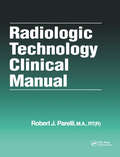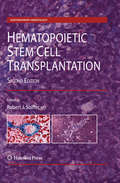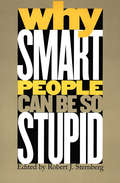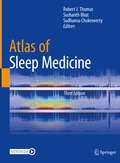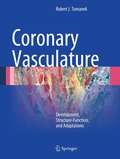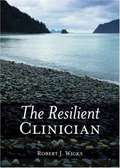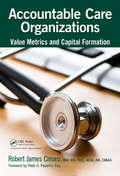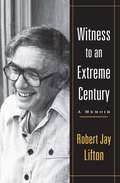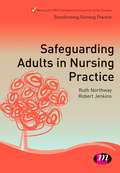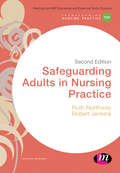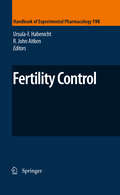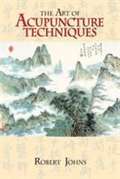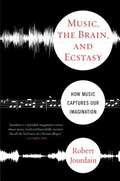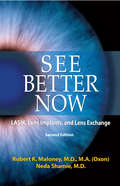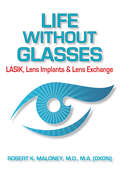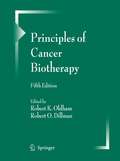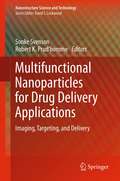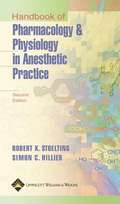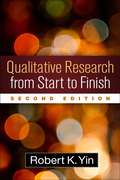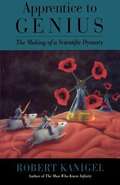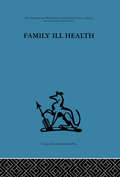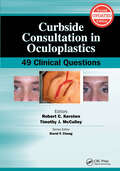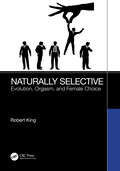- Table View
- List View
Radiologic Technology Clinical Manual
by Robert J. ParelliThe Radiologic Technology Clinical Manual is designed to guide students through all aspects of clinical training in the area of radiological sciences. This practical workbook contains student self-evaluation forms, course outlines, instructional objectives, and all the procedures and work assignments necessary for training students in the clinical side of radiologic technology. It can be used as a supplement to any radiologic sciences program.When used as part of an occupational training course in radiologic technology, the Radiologic Technology Clinical Manual will help students qualify for examination by the American Registry of Radiologic Technologists (ARRT). The book contains valuable record keeping materials for clinical experience hours, background on the profession as a whole, and evaluation forms for quarterly periods of clinical training. Time sheets, attendance forms, and clinical log forms are also included.
Hematopoietic Stem Cell Transplantation
by Robert J. SoifferRemarkable developments in the field of transplantation have created opportunities to address the formidable challenges of transplantation across histocompatibility barriers, stem cell expansion, and prevention of complications and generation of graft-vs-tumor activity to eradicate residual disease. Stem Cell Transplantation for Hematologic and Other Disorders, Second Edition provides a glimpse into potential future applications of bone marrow derived stem cells in the field of cardiac repair. The updated chapters introduce the biologic underpinnings of hematopoietic cell transplantation, basic stem cell biology, immunobiology, and histocompatibility, with emphasis on indications and results of transplantation for specific diseases. Written by experts in the field, Stem Cell Transplantation for Hematologic Disorders, Second Edition provides seasoned professionals with a complete understanding of the current state of transplantation biology as well as a clear vision into the future.
Why Smart People Can Be So Stupid
by Robert J. Sternberg&“A serious attempt to understand a common phenomenon&” from the author of The Nature of Human Intelligence (Psychology Today). One need not look far to find breathtaking acts of stupidity committed by people who are smart, or even brilliant. The behavior of clever individuals—from presidents to prosecutors to professors—is at times so amazingly stupid as to seem inexplicable. Why do otherwise intelligent people think and behave in ways so stupid that they sometimes destroy their livelihoods or even their lives? This is an investigation of psychological research to see what it can tell us about stupidity in everyday life. The contributors to the volume—scholars in various areas of human intelligence—present examples of people messing up their lives, and offer insights into the reasons for such behavior. From a variety of perspectives, the contributors discuss: The nature and theory of stupidityHow stupidity contributes to stupid behaviorWhether stupidity is measurable. While many millions of dollars are spent each year on intelligence research and testing to determine who has the ability to succeed, next to nothing is spent to determine who will make use of their intelligence and not squander it by behaving stupidly. The contributors focus on the neglected side of this discussion, reviewing the full range of theory and research on stupid behavior and analyzing what it tells us about how people can avoid stupidity and its devastating consequences. &“Marvelous, devilishly clever, and culturally timely book . . . A fascinating exploration.&” —Choice &“Easily readable and well referenced . . . May provide just enough momentum for change.&” —International Journal of Intelligence
Atlas of Sleep Medicine
by Robert J. Thomas Sudhansu Chokroverty Sushanth BhatThis authoritative and updated Atlas provides a comprehensive span of topics across all of sleep medicine, including old to futuristic approaches. It captures the significant changes and advances in the field and a wealth of new visual information available since the last edition. Edited and contributed by leaders in the art and science of sleep medicine, the Atlas highlights how the field of sleep medicine is truly a mix of several medical specialties. The field continues to rapidly evolve with research leading to some future directions. This Atlas remains a standard reference for Sleep Physicians, including Sleep Fellows and other trainees in Sleep Medicine, Sleep Technologists, and Sleep researchers.
Coronary Vasculature: Development, Structure-Function, and Adaptations
by Robert J. TomanekIschemic heart disease is the leading cause of morbidity and mortality in the developed world. The high metabolism and oxygen demand of the cardiac myocardium depends on both a high blood flow and a rich capillary density. For this reason, the growth of the coronary vasculature is vital, not only in early development, but also in the adult faced with various stresses. Novel technologies have enabled the discovery of the molecular mechanisms underlying the growth and assembly coronary vessels, and this volume covers the hierarchy of the coronary vasculature from its embryonic origins through its postnatal growth, adulthood, and senescence. Chapters address normal coronary development, coronary anomalies and their possible underlying developmental errors, coronary vessel adaptations to exercise training, aging, hypoxia, myocardial ischemia, and cardiac hypertrophy. This comprehensive overview of current research in coronary vessels and myocardial perfusion was written by Dr. Robert J. Tomanek, Emeritus Professor of Anatomy and Cell Biology at the University of Iowa. The book reviews, discusses, and integrates findings from various areas of coronary vasculature research, and as a result, will be a valuable reference source for cardiovascular scientists and physicians for many years to come.
The Resilient Clinician
by Robert J. WicksThis immensely readable book also includes one of the most current selective bibliographies of relevant research and clinical and theoretical publications in the subject area, from common stressors and vicarious post-traumatic stress disorders to burnout and compassion fatigue.
Environmental Enrichment for Captive Animals (UFAW Animal Welfare #1)
by Robert J. YoungEnvironmental enrichment is a simple and effective means of improving animal welfare in any species – companion, farm, laboratory and zoo. For many years, it has been a popular area of research, and has attracted the attention and concerns of animal keepers and carers, animal industry professionals, academics, students and pet owners all over the world. This book is the first to integrate scientific knowledge and principles to show how environmental enrichment can be used on different types of animal. Filling a major gap, it considers the history of animal keeping, legal issues and ethics, right through to a detailed exploration of whether environmental enrichment actually works, the methods involved, and how to design and manage programmes. The first book in a major new animal welfare series Draws together a large amount of research on different animals Provides detailed examples and case studies An invaluable reference tool for all those who work with or study animals in captivity This book is part of the UFAW/Wiley-Blackwell Animal Welfare Book Series. This major series of books produced in collaboration between UFAW (The Universities Federation for Animal Welfare), and Wiley-Blackwell provides an authoritative source of information on worldwide developments, current thinking and best practice in the field of animal welfare science and technology. For details of all of the titles in the series see www.wiley.com/go/ufaw.
Accountable Care Organizations: Value Metrics and Capital Formation
by Robert James CimasiAn accountable care organization (ACO) is a healthcare organization characterized by a payment and care delivery model that seeks to tie provider reimbursements to quality metrics and reductions in the total cost of care for an assigned group of patients. Accountable Care Organizations: Value Metrics and Capital Formation explores the historical ba
Witness to an Extreme Century
by Robert Jay LiftonOn a fateful day in the spring of 1954 Robert Jay Lifton, a young American psychiatrist just discharged from service in the Korean War, decided to stay in Hong Kong rather than return home--changing his life plans entirely--so that he could continue work that had enthralled him, interviewing people subjected to Chinese thought reform. He had plunged into uncharted territory in probing the far reaches of the human psyche, as he would repeatedly in the years ahead, and his Hong Kong research provided the first understanding of the insidious process that came to be known as brainwashing. From that day in Hong Kong forward, Lifton has probed into some of the darkest episodes of human history, bearing his unique form of psychological witness to the sources and consequences of collective violence and trauma, as well as to our astonishing capacity for resilience. In this long-awaited memoir, Lifton charts the adventurous and constantly surprising course of his fascinating life journey, a journey that took him from what a friend of his called a "Jewish Huck Finn childhood" in Brooklyn to friendships with many of the most influential intellectuals, writers, and artists of our time--from Erik Erikson, David Riesman, and Margaret Mead, to Howard Zinn and Kurt Vonnegut, Stanley Kunitz, Kenzaburo Oe, and Norman Mailer. In his remarkable study of Hiroshima survivors, he explored the human consequences of nuclear weapons, and then went on to uncover dangerous forms of attraction to their power in the spiritual disease he calls nuclearism. During riveting face-to-face interviews with Nazi doctors, he illuminated the reversal of healing and killing in ordinary physicians who had been socialized to Nazi evil. With Vietnam veterans he helped create unprecedented "rap groups" in which much was revealed about what we now call post-traumatic stress disorder, helping veterans draw upon their experience for valuable, even prophetic, insights about atrocity and war. As a pioneer in psychohistory, Lifton's encounters with the consequences of cruelty and destructiveness led him to become a passionate social activist, lending a powerful voice of conscience to the suppressed truths of the Vietnam War and the dangers of nuclear weapons. Written with the warmth of spirit--along with the humor and sense of absurdity--that have made Lifton a beloved friend and teacher to so many, Witness to an Extreme Century is a moving and deeply thought-provoking story of one man's extraordinary commitment to looking into the abyss of evil in order to help us move beyond it.
Witness to an Extreme Century: A Memoir
by Robert Jay LiftonOn a fateful day in the spring of 1954 Robert Jay Lifton, a young American psychiatrist just discharged from service in the Korean War, decided to stay in Hong Kong rather than return home--changing his life plans entirely--so that he could continue work that had enthralled him, interviewing people subjected to Chinese thought reform. He had plunged into uncharted territory in probing the far reaches of the human psyche, as he would repeatedly in the years ahead, and his Hong Kong research provided the first understanding of the insidious process that came to be known as brainwashing. From that day in Hong Kong forward, Lifton has probed into some of the darkest episodes of human history, bearing his unique form of psychological witness to the sources and consequences of collective violence and trauma, as well as to our astonishing capacity for resilience. In this long-awaited memoir, Lifton charts the adventurous and constantly surprising course of his fascinating life journey, a journey that took him from what a friend of his called a "Jewish Huck Finn childhood" in Brooklyn to friendships with many of the most influential intellectuals, writers, and artists of our time--from Erik Erikson, David Riesman, and Margaret Mead, to Howard Zinn and Kurt Vonnegut, Stanley Kunitz, Kenzaburo Oe, and Norman Mailer. In his remarkable study of Hiroshima survivors, he explored the human consequences of nuclear weapons, and then went on to uncover dangerous forms of attraction to their power in the spiritual disease he calls nuclearism. During riveting face-to-face interviews with Nazi doctors, he illuminated the reversal of healing and killing in ordinary physicians who had been socialized to Nazi evil. With Vietnam veterans he helped create unprecedented "rap groups" in which much was revealed about what we now call post-traumatic stress disorder, helping veterans draw upon their experience for valuable, even prophetic, insights about atrocity and war. As a pioneer in psychohistory, Lifton's encounters with the consequences of cruelty and destructiveness led him to become a passionate social activist, lending a powerful voice of conscience to the suppressed truths of the Vietnam War and the dangers of nuclear weapons. Written with the warmth of spirit--along with the humor and sense of absurdity--that have made Lifton a beloved friend and teacher to so many, Witness to an Extreme Century is a moving and deeply thought-provoking story of one man's extraordinary commitment to looking into the abyss of evil in order to help us move beyond it.
Safeguarding Adults in Nursing Practice
by Robert Jenkins Ruth NorthwayAll nurses, whatever setting they work in, are likely to encounter people who are at risk of abuse and neglect. Recent reports have highlighted poor care and abuse and safeguarding adults is therefore a key requirement in pre-registration programmes. This book seeks to raise nurses' awareness of vulnerability, abuse and neglect whilst providing them with the knowledge and skills required to safeguard those within their care. It encourages them to make links between theory and practice, to think critically in order to achieve the necessary balance between protection and empowerment and to examine how their personal practice may be improved.
Safeguarding Adults in Nursing Practice (Transforming Nursing Practice)
by Robert Jenkins Ruth NorthwayAll nurses, whatever setting, will encounter people who are at risk. Harrowing examples of abuse and neglect are frequently in the headlines and the nursing profession has a crucial responsibility to play in ensuring that vulnerable patients are cared for and safeguarded. This Second Edition answers all of the key questions including: What is neglect? What makes someone vulnerable? What role does safeguarding play? What does good safeguarding look like? Why can safeguarding fail? How can positive practice be developed? What are the professional and legal responsibilities facing nurses? This helpful resource will improve readers’ understanding of the policy, practice, and research underpinning safeguarding, while also preparing them for their important role as an advocate for, and safeguarder of, the people in their care. Transforming Nursing Practice is a series created for pre-registration student nurses. Each book in the series is: Affordable Mapped to the NMC Standards and Essential Skills Clusters Focused on applying theory to practice Full of active learning features "The set of books is an excellent resource for students. The series is small, easily portable, and valuable. I use the whole set on a regular basis." —Fiona Davies, Senior Nurse Lecturer, University of Derby
Fertility Control
by Robert John Aitken Ursula-F. HabenichtThis book represents a unique collection of papers from internationally renowned experts to give us a state-of-the art summary of current concepts in reproductive biology. The narrative has been developed to highlight how new gains in our understanding of reproductive mechanisms have generated unique opportunities for contraceptive development.
The Art of Acupuncture Techniques
by Robert JohnsAcupuncture patients who want the nitty-gritty of such needling techniques as depth, placement, and needle type should read The Art of Acupuncture Techniques. It's unique historical perspective preserves theoretical concepts that haven't been taught in China since the Cultural Revolution. If you really want to know what's going on during treatment, whether you're seeking relief from a skin condition, angina, or infertility, it's right on target.
Music, The Brain, And Ecstasy
by Robert JourdainWhat makes a distant oboe's wail beautiful? Why do some kinds of music lift us to ecstasy, but not others? How can music make sense to an ear and brain evolved for detecting the approaching lion or tracking the unsuspecting gazelle? Lyrically interweaving discoveries from science, psychology, music theory, paleontology, and philosophy, Robert Jourdian brilliantly examines why music speaks to us in ways that words cannot, and why we form such powerful connections to it. In clear, understandable language, Jourdian expertly guides the reader through a continuum of musical experience: sound, tone, melody, harmony, rhythm, composition, performance, listening, understanding--and finally to ecstasy. Along the way, a fascinating cast of characters brings Jourdian's narrative to vivid life: "idiots savants" who absorb whole pieces on a single hearing, composers who hallucinate entire compositions, a psychic who claims to take dictation from long-dead composers, and victims of brain damage who can move only when they hear music. Here is a book that will entertain, inform, and stimulate everyone who loves music--and make them think about their favorite song in startling new ways.
See Better Now: LASIK, Lens Implants and Lens Exchange
by Robert K MaloneyNearly 3.6 million Americans have their vision surgically corrected annually; it is the most commonly performed surgery in the nation. Even so, many people find themselves feeling anxious about the procedure. Author Robert K. Maloney is an experienced ophthalmologist who has performed thousands of vision correction surgeries. Not only is he an expert at performing these surgeries, he is a compassionate physician who understands the kinds of questions and concerns people have. In this book he covers LASIK and PRK surgeries, the differences between RLE and ICL, the implantable contact lens, refractive lens exchanges, how to choose a surgeon, and the newest vision correction surgery techniques.
Life without Glasses: LASIK, Lens Implants & Lens Exchange
by Robert K. MaloneyNearly 3.6 million Americans have their vision surgically corrected annually; it is the most commonly performed surgery in the nation. Even so, many people find themselves feeling anxious about the procedure. Author Robert K. Maloney is an experienced ophthalmologist who has performed thousands of vision correction surgeries. Not only is he an expert at performing these surgeries, he is a compassionate physician who understands the kinds of questions and concerns people have. In this book he covers LASIK and PRK surgeries, the differences between RLE and ICL, the implantable contact lens, refractive lens exchanges, how to choose a surgeon, and the newest vision correction surgery techniques.
Principles of Cancer Biotherapy
by Robert K. Oldham Robert O. DillmanAt the time of the first edition of Principles of Cancer Biotherapy in 1987, this book represented the first comprehensive textbook on biological therapy. In 1991, when the second edition was published, there was still some doubt on the part of many oncologists and cancer researchers as to the therapeutic value of these new approaches. By 2003 and the fourth edition, it was generally agreed that biopharmaceuticals were producing major opportunities for new cancer therapies. Cancer biotherapy has now truly matured into the fourth modality of cancer treatment. This fifth revised edition describes the tremendous progress that has been made in recent years using biologicals in cancer treatment. This book summarizes an evolving science and a rapidly changing medical practice in biotherapy. In this new millennium, it is now possible to envision a much more diversified system of cancer research and treatment that will afford greater opportunities for a patient's personalized cancer treatment. This was first envisioned in the 1987 initial edition of this textbook and is now a "new" and popular approach to cancer treatment. Some forms of cancer biotherapy use the strategy of tumor stabilization and control through continued biological therapy, akin to the use of insulin in the treatment of diabetes. This textbook illustrates new methods of thinking and new strategies for control of cancer. It is always difficult to move from past dogma to future opportunity, but this fifth edition of Principles of Cancer Biotherapy illustrates why it is so important to the patients for researchers and clinicians to explore and quickly apply these new opportunities in cancer biotherapy.
Multifunctional Nanoparticles for Drug Delivery Applications
by Robert K. Prud'Homme Sonke SvensonThis book clearly demonstrates the progression of nanoparticle therapeutics from basic research to applications. This book, unlike others covering nanoparticles used in medical applications, presents the medical challenges that can be reduced or even overcome by recent advances in nanoscale drug delivery. Each chapter highlights recent progress in the design and engineering of select multifunctional nanoparticles with topics covering targeting, imaging, delivery, diagnostics, and therapy.
Handbook of Pharmacology and Physiology in Anesthetic Practice
by Robert K. Stoelting Simon C. HillierDesigned for quick reference in the operating room or rapid review for board exams, this handbook presents the most critical clinical information from the newly updated Fourth Edition of Pharmacology and Physiology in Anesthetic Practice.
Qualitative Research from Start to Finish, Second Edition
by Robert K. YinThis book will help readers understand the practice of qualitative research--whether they want to do it, teach it, or just learn about it. All the major research phases are encompassed (startup, design, data collection, analysis, and composing), including newly emerging trends. Numerous easy-to-read vignettes show how other scholars have successfully implemented specific procedures. Equally distinctive, the book presents qualitative research as an adaptive craft. The array of choices among different procedures and methods enables readers to customize their own studies and to accommodate different worldviews and genres. New to This Edition: *Stronger discussion of different worldviews (e.g., constructivism, postpositivism, and pragmatism) and how they relate to different methodological choices. *Clearer emphasis on doing a generalized qualitative study, while acknowledging 12 specialized genres (e.g., action-based research, arts-based research, autoethnography, grounded theory, phenomenology, and others). *Expanded discussions of different kinds of qualitative study samples and of mixed methods. *New ideas on how to avoid getting stalled when analyzing qualitative data. *Consideration of an additional way of concluding a qualitative study: by taking action. Pedagogical Features: *Chapters start with an abstract and end with a suggested exercise. *Key terms and concepts appear in boldface throughout the text and are listed in end-of-chapter recaps as well as in the book's glossary. *Sections within each chapter start with a preview box: "What you should learn from this section." *An appendix presents a semester- or yearlong field-based project.
Apprentice To Genius: The Making Of A Scientific Dynasty
by Robert KanigelRobert Kanigel takes us into the heady world of a remarkable group of scientists working at the National Institutes of Health and the Johns Hopkins University: a dynasty of American researchers who for over forty years have made Nobel Prize- and Lasker Award-winning breakthroughs in biomedical science.
Family Ill Health: An investigation in general practice
by Robert KellnerTavistock Press was established as a co-operative venture between the Tavistock Institute and Routledge & Kegan Paul (RKP) in the 1950s to produce a series of major contributions across the social sciences. This volume is part of a 2001 reissue of a selection of those important works which have since gone out of print, or are difficult to locate. Published by Routledge, 112 volumes in total are being brought together under the name The International Behavioural and Social Sciences Library: Classics from the Tavistock Press. Reproduced here in facsimile, this volume was originally published in 1963 and is available individually. The collection is also available in a number of themed mini-sets of between 5 and 13 volumes, or as a complete collection.
Curbside Consultation in Oculoplastics: 49 Clinical Questions (Curbside Consultation in Ophthalmology)
by Robert Kersten Timothy McCulleyCurbside Consultation in Oculoplastics has been updated into a Second Edition! The Second Edition contains new questions and is completely updated! Curbside Consultation in Oculoplastics: 49 Clinical Questions, Second Edition contains new questions and brief, practical, evidence-based answers to the most frequently asked questions that are posed during a “curbside consultation” between surgical colleagues. Dr. Robert C. Kersten and Dr. Timothy J. McCulley have designed this unique reference in which oculoplastic specialists offer expert advice, preferences, and opinions on tough clinical questions commonly associated with ocuplastics. The unique Q&A format provides quick access to current information related to oculoplastics with the simplicity of a conversation between two colleagues. Images, diagrams, and references are included to enhance the text and to illustrate common clinical dilemmas.Some of the questions that are answered inside theSecond Editioninclude: What lasers do you prefer for facial resurfacing? When do you worry that an eyelid growth is malignant? What are the general treatment guidelines for graves ophthalmopathy? How do I know when to order and MRI or CT? What is the best approach to manage trichiasis? How do I decide whether to perform an enucleation or an evisceration? Curbside Consultation in Oculoplastics: 49 Clinical Questions, Second Edition provides information basic enough for residents while also incorporating expert pearls that even high-volume ophthalmologists will appreciate. Residents, fellows, and practicing physicians alike will benefit from the user-friendly, casual format and the expert advice contained within.
Naturally Selective: Evolution, Orgasm, and Female Choice
by Robert KingResearchers of human behaviour have identified an "orgasm gap": Men usually orgasm during intercourse, whereas women often do not. This book addresses this mystery. The two leading explanations are either that women are “psychologically broken” - Freud’s theory – or badly designed – the “by-product theory.” However, there is a much more compelling third explanation. Evolutionary biology, anatomy, physiology, and direct sex research suggest women have evolved under their own selection pressures and orgasm is a fitness-increasing consequence of such selective factors. This is revealed in their patterns of orgasmic response, which are neither random nor inexplicable.Key Features• Synthesizes decades of peer-reviewed sex research in anatomy, biology, physiology, and behavior.• Engagingly written based on feedback from students, peers, and interested lay persons.• Makes sense of the “orgasm gap” between men and women.• Provides a wider context of human sexual dimorphism and mutual sexual selection.• Balances sex research and real-world research and practical applications.
